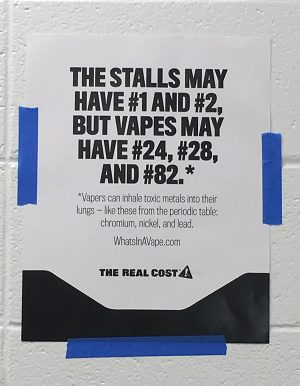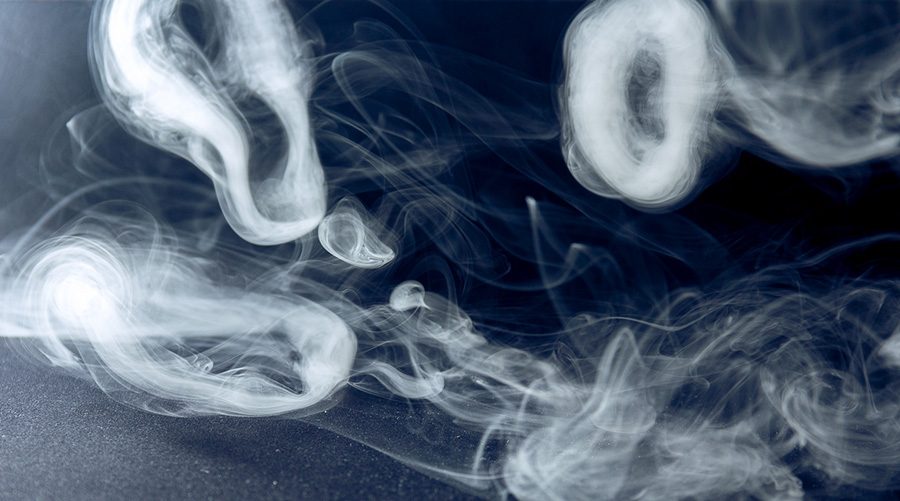Smoke and bathroom mirrors
Vaping epidemic sweeps the Mill
Photo via Shutterstock (Leporel) via Creative Commons license
Vaping among high school students has shot up throughout the country. How will Starr’s Mill respond?
Food and Drug Administration commissioner Scott Gottlieb announced less than a month ago the “largest ever coordinated initiative against violative sales in the history of the FDA.” The offender? The vaping industry.
The number of teenagers using e-cigarettes has shot up in recent years, and Starr’s Mill is far from untouched from what is now being called an epidemic. Given the controversy surrounding vaping and the potential life-threatening consequences, this school year is bound to be a tumultuous one for faculty and students alike.
Principal’s advice: “Don’t vape, kids.”
Except it’s a little more complicated than that.
Not only is vaping a rising problem, but use at Starr’s Mill has gotten rather blatant. “[At] Starr’s Mill in particular, we have seen an explosion of vaping in school, predominantly in the bathrooms, but we have also seen and heard of people doing it in classrooms, and in offices, for that matter,” Principal Allen Leonard said. “I had a student actually vape in my office last year, which added to the trouble they were already in.”
The vaping problem seems to be deeply rooted. One issue, Leonard mentioned, has been ignorance regarding what vapes are and how they work. “A lot of parents don’t understand the danger, the addictive nature of the nicotine that’s in the vast majority of these devices, and a lot of times parents don’t even know that the kids have them, because they’re so small and easily hidden,” Leonard said.
Hopefully in time, especially considering the news right now, information on the issue will spread. The end goal of this education on e-cigarettes is creating a cultural stigma, the same kind of stigma that’s formed around smoking in the last few decades.
“High school actual tobacco use has dropped precipitously over the last forty years or so, and it would be very rare to find a student at Starr’s Mill that actually smokes real cigarettes these days,” Leonard said. “The [vapes] have been marketed as a healthy alternative…We’re now finding out that they’re not so healthy.”
But beyond just not knowing any better, what’s fueling this behavior among teenagers? Why are the conversations about potential risks not working right now? Leonard points out two additional problems.
“Number one, [students who vape] don’t realize they’re addicted to nicotine. That’s the behavior of an addict,” Leonard said. “The second thing is that teenagers like to get away with stuff. It was the same way when I was in school. It’s the mentality that ‘nothing bad is ever going to happen to me, and I’m not going to get caught’ that’s common among teenagers.”
So until vaping is properly stigmatized in society, it doesn’t seem much will change, especially considering the natural risk factors for addiction embedded in simply being a teenager.
That moment may come soon, or it may be another forty years. In any case, schools will certainly be a part of accelerating the rate at which the stigma is adopted.
In the meantime, catching students who vape is the main tool for Starr’s Mill to curb the behavior. “We are in bathrooms at every class change and during lunch period. The hard part about these particular devices is that there is no stinky residue. It doesn’t take but about five seconds to take a hit off a vape. This is the number one safety issue we’re having to deal with this year,” Leonard said.
Since this is such a new issue, there isn’t a lot of disciplinary infrastructure in place to solve it, thus the one-note, bathroom-patrolling tactic. But that could change. “One of the things that we’re looking at potentially doing is setting up a way for our students to anonymously turn people in,” Leonard said. “Now, if a student turns someone in, by the time we get there that student who was vaping is gone. But what we’ll do is look at patterns.”
But when a student does get caught with a vape and is sent to Leonard’s office, how effective are consequences in deterring further offences? According to Leonard, it’s fairly so.
“It is a very rare situation in my thirteen-year history that I can think of where a student got two tobacco charges in the same year,” Leonard said. “That doesn’t mean that they’ve necessarily quit. It could be that they’ve gotten better at hiding it, or it could be that they’ve realized not to bring it to school. But that certainly is something that [we] would work with their parents on and try to communicate about the addiction piece as well, so that the kids know what’s going on.”
But if this is a new wave of nicotine addiction, will the same principle hold true? It’s hard to be certain, and a lot will depend on how quickly the stigma develops.

As part of the FDA’s “The Real Cost” campaign, signs about the dangers of vaping are posted in bathrooms around the Mill. This may be the first step to stigmatizing the use of vapes.
Teacher utilizing expertise to educate
Robin Huggins is an anatomy, epidemiology, and chemistry teacher at Starr’s Mill. She’s able to look at the vaping problem both as a teacher and as a scholar of science.
It can be difficult to understand why vaping has so much potential danger. Huggins explained: “When you smoke a cigarette, the nicotine in tobacco is a bigger molecule, and so it doesn’t get as far down into your respiratory system. And when you inhale what’s in the Juul or in the vape, it’s a smaller molecule and it’s more concentrated, so you’re getting more nicotine.”
The evidence on vaping is somewhat mixed, but in any case, even if vapes allow inhaling of nicotine without the other damaging substances present in cigarettes, it’s still nicotine and still addictive. A lot of the damage remains to be seen.
This uncertainty is very problematic to Huggins. “As a teacher, it really concerns me. First of all, if kids know what they’re doing they don’t care, that is a whole issue in and of itself,” Huggins said. “I just feel like it’s one of those things that fifteen years from now, just like with cigarettes and other things, we’re going to find out the issues and the kids are going to have been using these chemicals, and it’s going to end up catching up with them.”
Huggins feels there’s a lot to be done to curb vaping, both with regards to education and enforcement. “And I think our responsibility is, first of all, especially as a chemistry teacher and an anatomy teacher, to educate kids about what they’re doing,” Huggins said. “And another thing is that we just have to step it up. I was shocked when I found out how many kids were doing it, how prevalent it was. And the fact that they could be doing it in my classroom. That’s what’s amazing to me.”
For students, vaping is both a troubling trend and a passing annoyance
Quinn Biddle and Zachary Livsey are juniors at Starr’s Mill. For them, the vaping issue is a frustrating one.
Specifically, trying to use the bathroom can prove fruitless. “I was done with A lunch and I was just trying to go use the restroom. And there were so many kids vaping there, that I was not able to relieve myself,” Biddle said.
Funnily enough, Livsey had a similar experience. “Yeah, that exact same thing happened to me today. I was trying to go the bathroom outside the cafeteria and I couldn’t,” Livsey said.
Their stories also speak to the sheer volume of vaping incidents present at the Mill. “In fact, this classroom that we’re in right now — I’ve seen kids vaping during this class period,” Biddle said.
Biddle’s view of the situation puts a bit more pressure on the students. “But [Juul] are doing a lot to stop marketing it to teens. They’re spending a lot of money and using a lot of resources in trying to market away from teens, which is good, and I commend them for that,” Biddle said. “But it’s definitely the students’ responsibility. [Juul] could market it purely to teens and I’d still put it on the students. We’re at a time where we should know and be able to think things through before puffing a fat cloud of a Juul. I think it’s sad that you can’t go seven hours without getting a nicotine fix.”
Livsey’s concern lies with addiction among students. “[Addiction] has been exacerbated by the Juul. There’s [a student] in our grade…he’s having a real tough time, apparently,” Livsey said.
Another contributor to the problem is that high school students 18 and older are the ones providing their peers with vapes. “They do something called pod runs or vape runs. They just buy a ton of vapes or vape juice, or whatever, and sell it to the younger kids,”Livsey said “They can make quite a killing. It’s a complete business model. I admire them, almost, for it.”
When asked for closing remarks, Biddle warned, “I snitch [on students who vape].” Livsey’s sentiment wasn’t so far off: “Vaping is bad, and if you’re a vapist, you’re a loser.”
Student speaks on vaping’s larger culture
For a little bit more of an insight as to why kids want to justify vaping, senior Bailey Austin gave her thoughts.
“I think that vaping is popular just, because it’s become something that everybody does,” Austin said. “But I also think most people vape just for a buzz.” She also remarked that vaping often takes place “with friends outside of school or driving in their car.”
On long term solutions, Austin has more of a dismal view. “I think it’s something people should try to stay away from due to how addictive nicotine is,” Austin said. “But at the same time, I don’t feel like there are any steps the school can take at this point. I think the most anyone can do is just stress what a terrible habit it is to the middle school kids. High school is too far gone.”
The numbers are frightening. On the one hand, the FDA is taking action. On the other, an entire segment of the population may be well on their way to nicotine addiction. Will the stigma that’s been stressed as so key to solving this issue develop soon enough?
Time will tell. But before all of that unfolds, there seems to be plenty of individuals within Starr’s Mill willing to educate each other about the risks, even if the consequences won’t manifest for many years to come.


